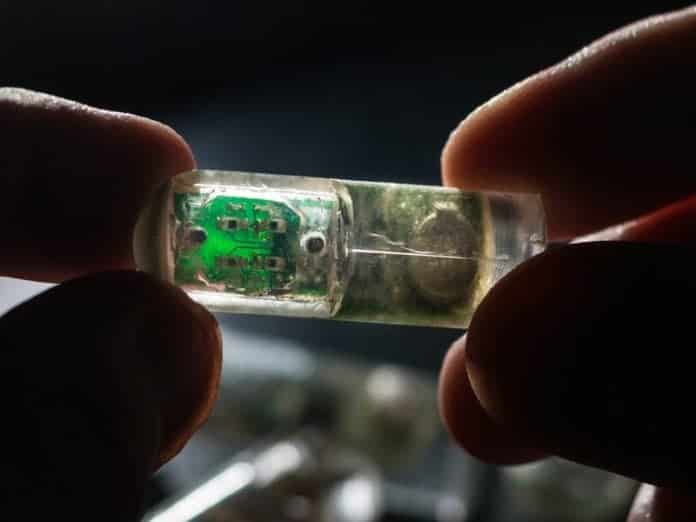Ingestible Sensor Laced with E.coli to Monitor Gut Health
Biomolecular observation in the gastrointestinal tract may provide rapid, accurate disease detection and direction but is eased by accessibility to the distant and complicated atmosphere.
Currently, researchers at MIT have developed an ingestible chip comprising genetically engineered E. coli. When consumed, the germs can detect blood flow in the gut, and generate light.
The processor includes elements that measure the quantity of light generated and relays this info into a local smartphone, enabling a very simple and noninvasive diagnosis of gastrointestinal distress.
For the team’s initial demonstration, they focused on bleeding in the GI tract. They engineered a probiotic strain of E. coli to express a genetic circuit that causes the bacteria to emit light when they encounter heme.
They proceeded by placing the bacteria into four wells on their custom-designed sensor, covered by a semipermeable membrane that allows small molecules from the surrounding environment to diffuse through.
Underneath each well is a phototransistor that can measure the amount of light produced by the bacterial cells and relay the information to a microprocessor that sends a wireless signal to a nearby computer or smartphone. The researchers also built an Android app that can
be used to analyze the data.The sensor, which is a cylinder about 1.5 inches long, requires about 13 microwatts of power. The researchers equipped the sensor with a 2.7-volt battery, which they estimate could power the device for about 1.5 months of continuous use. They say it could also be powered by a voltaic cell sustained by acidic fluids in the stomach, using technology previously build by the team.
“The focus of this work is on system design and integration to combine the power of bacterial sensing with ultra-low-power circuits to realize important health sensing applications,” Anantha Chandrakasan, dean of MIT’s School of Engineering and the Vannevar Bush Professor of Electrical Engineering and Computer Science, one of the senior authors of the study says.
“The goal with this sensor is that you would be able to circumvent an unnecessary procedure by just ingesting the capsule, and within a relatively short period of time you would know whether or not there was a bleeding event,” says co-lead author on the project, Mark Mimee.
“Most of the work we did in the paper was related to blood, but conceivably you could engineer bacteria to sense anything and produce light in response to that,” Mimee says. “Anyone who is trying to engineer bacteria to sense a molecule related to disease could slot it into one of those wells, and it would be ready to go.”
The researchers say the sensors could also be designed to carry multiple strains of bacteria, allowing them to diagnose a variety of conditions.
“Right now, we have four detection sites, but if you could extend it to 16 or 256, then you could have multiple different types of cells and be able to read them all out in parallel, enabling more high-throughput screening,” says Phillip Nadeau, one of the lead authors on the study.
































